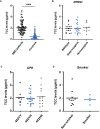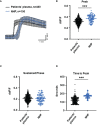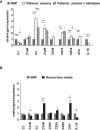Increased plasma level of terminal complement complex in AMD patients: potential functional consequences for RPE cells
- PMID: 37359546
- PMCID: PMC10287163
- DOI: 10.3389/fimmu.2023.1200725
Increased plasma level of terminal complement complex in AMD patients: potential functional consequences for RPE cells
Abstract
Purpose: Polymorphisms in complement genes are risk-associated for age-related macular degeneration (AMD). Functional analysis revealed a common deficiency to control the alternative complement pathway by risk-associated gene polymorphisms. Thus, we investigated the levels of terminal complement complex (TCC) in the plasma of wet AMD patients with defined genotypes and the impact of the complement activation of their plasma on second-messenger signaling, gene expression, and cytokine/chemokine secretion in retinal pigment epithelium (RPE) cells.
Design: Collection of plasma from patients with wet AMD (n = 87: 62% female and 38% male; median age 77 years) and controls (n = 86: 39% female and 61% male; median age 58 years), grouped for risk factor smoking and genetic risk alleles CFH 402HH and ARMS2 rs3750846, determination of TCC levels in the plasma, in vitro analysis on RPE function during exposure to patients' or control plasma as a complement source.
Methods: Genotyping, measurement of TCC concentrations, ARPE-19 cell culture, Ca2+ imaging, gene expression by qPCR, secretion by multiplex bead analysis of cell culture supernatants.
Main outcome measures: TCC concentration in plasma, intracellular free Ca2+, relative mRNA levels, cytokine secretion.
Results: TCC levels in the plasma of AMD patients were five times higher than in non-AMD controls but did not differ in plasma from carriers of the two risk alleles. Complement-evoked Ca2+ elevations in RPE cells differed between patients and controls with a significant correlation between TCC levels and peak amplitudes. Comparing the Ca2+ signals, only between the plasma of smokers and non-smokers, as well as heterozygous (CFH 402YH) and CFH 402HH patients, revealed differences in the late phase. Pre-stimulation with complement patients' plasma led to sensitization for complement reactions by RPE cells. Gene expression for surface molecules protective against TCC and pro-inflammatory cytokines increased after exposure to patients' plasma. Patients' plasma stimulated the secretion of pro-inflammatory cytokines in the RPE.
Conclusion: TCC levels were higher in AMD patients but did not depend on genetic risk factors. The Ca2+ responses to patients' plasma as second-messenger represent a shift of RPE cells to a pro-inflammatory phenotype and protection against TCC. We conclude a substantial role of high TCC plasma levels in AMD pathology.
Keywords: AMD serum; age-related macular degeneration; genetic risk factors; retinal pigment epithelium; terminal complement complex.
Copyright © 2023 Busch, Rau, Sekulic, Perie, Huber, Gehrke, Joussen, Zipfel, Wildner, Skerka and Strauß.
Conflict of interest statement
The authors declare that the research was conducted in the absence of any commercial or financial relationships that could be construed as a potential conflict of interest.
Figures











Similar articles
-
Assessment of Proteins Associated With Complement Activation and Inflammation in Maculae of Human Donors Homozygous Risk at Chromosome 1 CFH-to-F13B.Invest Ophthalmol Vis Sci. 2015 Jul;56(8):4870-9. doi: 10.1167/iovs.15-17009. Invest Ophthalmol Vis Sci. 2015. PMID: 26218915
-
Risk alleles in CFH and ARMS2 are independently associated with systemic complement activation in age-related macular degeneration.Ophthalmology. 2012 Feb;119(2):339-46. doi: 10.1016/j.ophtha.2011.07.056. Epub 2011 Nov 30. Ophthalmology. 2012. PMID: 22133792
-
Individuals homozygous for the age-related macular degeneration risk-conferring variant of complement factor H have elevated levels of CRP in the choroid.Proc Natl Acad Sci U S A. 2006 Nov 14;103(46):17456-61. doi: 10.1073/pnas.0606234103. Epub 2006 Nov 1. Proc Natl Acad Sci U S A. 2006. PMID: 17079491 Free PMC article.
-
Anaphylatoxin Signaling in Retinal Pigment and Choroidal Endothelial Cells: Characteristics and Relevance to Age-Related Macular Degeneration.Adv Exp Med Biol. 2018;1074:45-51. doi: 10.1007/978-3-319-75402-4_6. Adv Exp Med Biol. 2018. PMID: 29721926 Review.
-
Can innate and autoimmune reactivity forecast early and advance stages of age-related macular degeneration?Autoimmun Rev. 2017 Mar;16(3):231-236. doi: 10.1016/j.autrev.2017.01.005. Epub 2017 Jan 28. Autoimmun Rev. 2017. PMID: 28137479 Free PMC article. Review.
Cited by
-
Recent Advances in Our Understanding of Age-Related Macular Degeneration: Mitochondrial Dysfunction, Redox Signaling, and the Complement System.Aging Dis. 2024 Jan 24;16(3):1535-1575. doi: 10.14336/AD.2024.0124. Aging Dis. 2024. PMID: 38421830 Free PMC article. Review.
-
Factor-H-related protein 1 (FHR1), a promotor of para-inflammation in age-related macular degeneration.J Neuroinflammation. 2025 Jul 3;22(1):173. doi: 10.1186/s12974-025-03499-z. J Neuroinflammation. 2025. PMID: 40611130 Free PMC article.
References
-
- Armstrong RA, Mousavi M. Overview of risk factors for age-related macular degeneration (AMD). J Stem Cells (2015) 10:171–91. - PubMed
Publication types
MeSH terms
Substances
LinkOut - more resources
Full Text Sources
Medical
Miscellaneous

